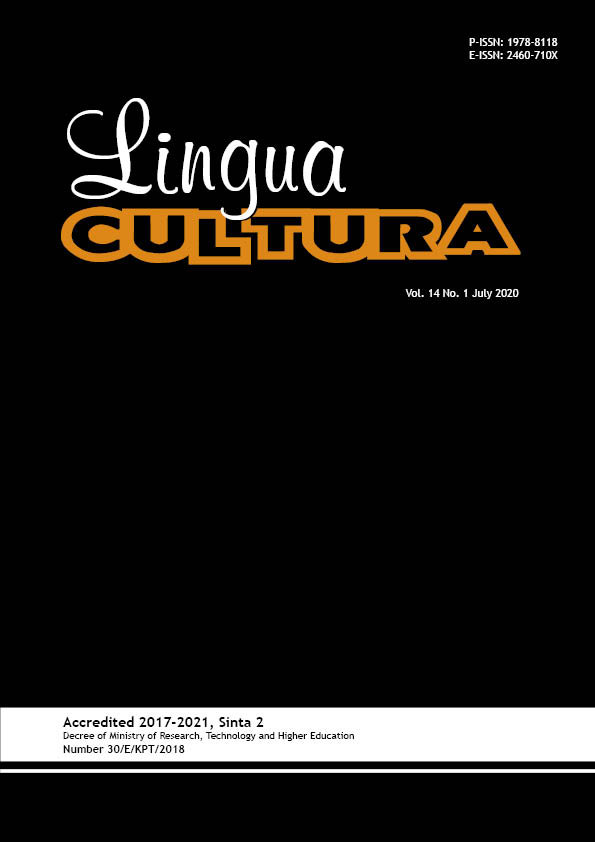The Effect of Google Classroom Assisted Extensive Listening on Listening Comprehension Accross Learning Autonomy
DOI:
https://doi.org/10.21512/lc.v14i1.6493Keywords:
google classroom assisted extensive listening, listening achievement, and learning autonomyAbstract
The research aimed at identifying the effect of Google Classroom Assisted Extensive Listening (EL) on English as a Foreign Language (EFL) Students’ Listening Comprehension across Learning Autonomy (i.e., high learning autonomy, and low learning autonomy). The research involved 78 students from two classes, which were divided into the experiment and control group. The experiment class was treated by practicing EL with the support of Google Classroom, on the other hand, the control group was treated by practicing EL by using the traditional platform (written listening journal). The students in each group were further grouped based on their autonomy level (high and low). The result of the research reveals that the mean score of the experiment group is much higher than the control class. It means that students who practiced EL with the support of Google Classroom have better listening comprehension as compared to the students who practiced EL by using the traditional platform. However, the research indicates no interaction from each learning autonomy level with the listening comprehension of both groups.Â
References
Balçikanli, C. (2010). Learner autonomy in language learning: Student teachers’ beliefs. Australian Journal of Teacher Education, 35(1), 90-103. https://doi.org/10.14221/ajte.2010v35n1.8.
Chang, A. C. S., & Millett, S. (2016). Developing L2 listening fluency through extended listening-focused activities in an extensive listening programme. RELC Journal, 47(3), 349-362. https://doi.org/10.1177/0033688216631175.
Chang, A., Millett, S., & Renandya, W. A. (2019). Developing listening fluency through supported extensive listening practice. RELC Journal, 50(3), 422-438. https://doi.org/10.1177/0033688217751468.
Chen, C. W. (2019). Guided listening with listening journals and curated materials: A metacognitive approach. Innovation in Language Learning and Teaching, 13(2), 133-146. https://doi.org/10.1080/17501229.2017.1381104.
Chun, D., Kern, R., & Smith, B. (2016). Technology in language use, language teaching, and language learning. Modern Language Journal, 100(S1), 64-80. https://doi.org/10.1111/modl.12302.
Everhard, C. J., & Murphy, L (Eds). (2015). Assessment and autonomy in language learning. London: Palgrave Macmillan.
Gay, L. R., Mills, G. E. (2016). Educational research: Competencies for analysis and applications (11th ed.). London: Pearson.
Hussin, A. A. (2018). Education 4.0 made simple: Ideas for teaching. International Journal of Education and Literacy Studies, 6(3), 92-98. http://dx.doi.org/10.7575/aiac.ijels.v.6n.3p.92.
Ivone, F. M., & Renandya, W. A. (2019). Extensive listening and viewing in ELT. Teflin Journal, 30(2), 237-25. https://doi.org/10.15639/teflinjournal.v30i2/237-256.
Jacobs, G. M., & Renandya, W. A. (2015). Making extensive reading even more student centered. Indonesian Journal of Applied Linguistics, 4(2), 102-112. https://doi.org/10.17509/ijal.v4i2.691.
Pamuji, K. D., Waring, R., & Kurniawan, E. (2019). EFL teachers’ experiences in developing L2 proficiency through extensive listening. Teflin Journal, 30(2), 257-273. https://doi.org/10.15639/teflinjournal.v30i2/257-273.
Renandya, W. A., Hu, G., & Xiang, Y. U. (2015). Extensive reading coursebooks in China. RELC Journal, 46(3), 255-273. https://doi.org/10.1177/0033688215609216.
Renandya, W. A., & Jacobs, G. M. (2016). Extensive reading and listening in the L2 Classroom. English Language Teaching Today, 5, 97-110. https://doi.org/10.1007/978-3-319-38834-2_8.
Renandya, W. A., & Widodo, H. P. (2016). English language teaching today. Swiss: Springer.
Renandya, W. A., Hamied, F. A., & Nurkamto, J. (2018). English language proficiency in Indonesia: Issues and prospects. Journal of Asia TEFL, 15(3), 618-629. https://doi.org/10.18823/asiatefl.2018.15.3.4.618.
Richards, J. C. (2015). The changing face of language learning: Learning beyond the classroom. RELC Journal, 46(1), 5-22. https://doi.org/10.1177/0033688214561621.
Schmidt, A. (2016). Listening journals for extensive and intensive listening practice. English Teaching Forum, 54(2),2-11. https://doi.org/10.1533/9781845696313.1.222.
Smadi, M. A. L. M., Mohammad, A. H., & Rahman, F. A. (2020). Barriers in instructional technology integration in teachers in Social Studies at Jordan Elementary School. Pedagogia: Jurnal Pendidikan, 9(1), 35-44. https://doi.org/10.21070/pedagogia.v9i1.124.
Sofiana, N. (2015). Implementasi blended learning pada mata kuliah Extensive Listening. Jurnal Tarbawi, 12(1), 59-69. https://doi.org/10.34001/tarbawi.v12i1.303.
Tyas, A. S. P., Muam, A., Sari, Y. I. H., Dewantara, C. (2020). The effectiveness of blended learning in improving students’ workplace communication. Lingua Cultura, 14(1), 1-12. https://doi.org/10.21512/lc.v14i1.6130.
Vai, M., & Sosulski, K. (2020). Essential of online course design. Abingdon: Taylor & Francis.
Vendityaningtyas, V., & Styati, E. W. (2018). Effect of computer mediated communication and face-to-face communication on the students’ writing. Lingua Cultura, 12(3), 233-239. https://doi.org/10.21512/lc.v12i3.4235.
Downloads
Published
How to Cite
Issue
Section
License
Copyright (c) 2020 Lingua Cultura

This work is licensed under a Creative Commons Attribution-ShareAlike 4.0 International License.
Authors who publish with this journal agree to the following terms:
a. Authors retain copyright and grant the journal right of first publication with the work simultaneously licensed under a Creative Commons Attribution License - Share Alike that allows others to share the work with an acknowledgment of the work's authorship and initial publication in this journal.
b. Authors are able to enter into separate, additional contractual arrangements for the non-exclusive distribution of the journal's published version of the work (e.g., post it to an institutional repository or publish it in a book), with an acknowledgment of its initial publication in this journal.
c. Authors are permitted and encouraged to post their work online (e.g., in institutional repositories or on their website) prior to and during the submission process, as it can lead to productive exchanges, as well as earlier and greater citation of published work.
USER RIGHTS
All articles published Open Access will be immediately and permanently free for everyone to read and download. We are continuously working with our author communities to select the best choice of license options, currently being defined for this journal as follows: Creative Commons Attribution-Share Alike (CC BY-SA)


















